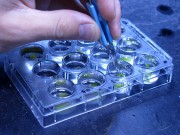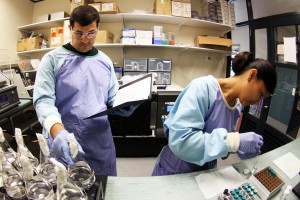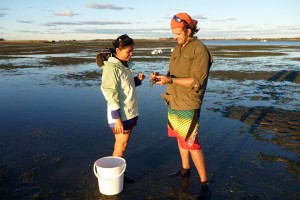NERP TE Project 4.2 - The chronic effects of pesticides and their persistence in tropical waters (AIMS)
Project summary
Pesticides, and particularly herbicides from agricultural sources, have been detected in nearshore sites of the Great Barrier Reef (GBR) all year round. The actual impacts from these concentrations of herbicides is under debate and information on cumulative impacts is required. To address this, a series of experiments will examine how plants and corals are affected by herbicides in the water in conjunction with other stressors such as temperature, low salinity and low light. An important source of herbicides in coastal waters is flood plumes from river runoff. By creating experimental conditions similar to GBR flood plumes we will determine how long herbicides persist and how they are transformed as they travel into coastal waters.
Why this research is needed
We lack fundamental knowledge about the fate and persistence of herbicides on the GBR. There are few data to explain the extent to which sensitive tropical organisms such as corals, and especially seagrass, are affected by chronic exposure to herbicides combined with increased sea temperature and/or declines in salinity and light.
Research user focus
Research knowledge from this project will contribute to Queensland and Australian Government policy development to protect the GBR from the effects of pollution and climate change. Data will inform Reef Rescue projects and Reef Plan and facilitate management of the GBR by the Great Barrier Reef Marine Park Authority (GBRMPA). Other research users include DSEWPaC, Queensland Department of Environment and Heritage Protection, Terrain NRM, Burdekin Dry Tropics NRM, Fitzroy Basin Association, Canegrowers and WWF.
Outcomes:
- Threshold concentrations for chronic effects of herbicides on seagrass
- An assessment of whether managing chronic herbicide exposures can protect seagrasses and corals from climate change pressures (e.g. thermal stress)
- Identification of half-lives of herbicides at multiple temperatures
- Quantification of herbicide breakdown products and their potential toxicity.
Project contact
Dr Andrew Negri, Australian Institute of Marine Science, A.Negri@aims.gov.au
Reports, Publications and News
For more information see Project 4.2 'The chronic effects of pesticides and their persistence in tropical waters' on the NERP Tropical Ecosystems Hub site.
Images
Datasets

This dataset shows the concentrations of the herbicide glyphosate remaining over time in a simulation flask persistence experiment conducted in 2013.
Glyphosate degradation experiments were carried out in flasks according to the OECD methods for ‘‘simulation tests’’. The tests used natural coastal seawater and were carried out in the incubator shakers under 3 conditions: (1) 25°C in the dark, (2) 31°C in the dark and (3) 25°C in the light. The light levels were ~40 µE on a 12:12 light:dark cycle and the flasks shaken at 100 rpm for up to 330 days.

Pesticides, and particularly herbicides from agricultural sources, have been detected in nearshore sites of the Great Barrier Reef (GBR) all year round. The actual impact from these concentrations of herbicides is under debate and information on cumulative impacts is required. To address this, a series of experiments will examine how plants and corals are affected by herbicides in the water in conjunction with other stressors such as temperature, low salinity and low light. An important source of herbicides in coastal waters is flood plumes from river runoff.
This dataset shows the measured response of the photosystems of seagrasses to herbicides in experiments conducted in 2012-2013. The data is provided as a multi-sheet spreadsheet.

This dataset shows the measured response of the photosystems of seagrasses to herbicides in experiments conducted in 2014. The purpose of the experiments were to develop and validate a miniature toxicity assay using isolated seagrass leaves in 12-well plate.
This dataset shows the concentrations of multiple herbicides remaining over time in a simulation flask persistence experiment conducted in 2013.
The aim of this study was to quantify the persistence multiple herbicides in a standard flask experiment. Time it takes for degradation of half of this herbicide is termed the "half-life". The half-life can be used to help develop environmental risk assessments.
Methods:







